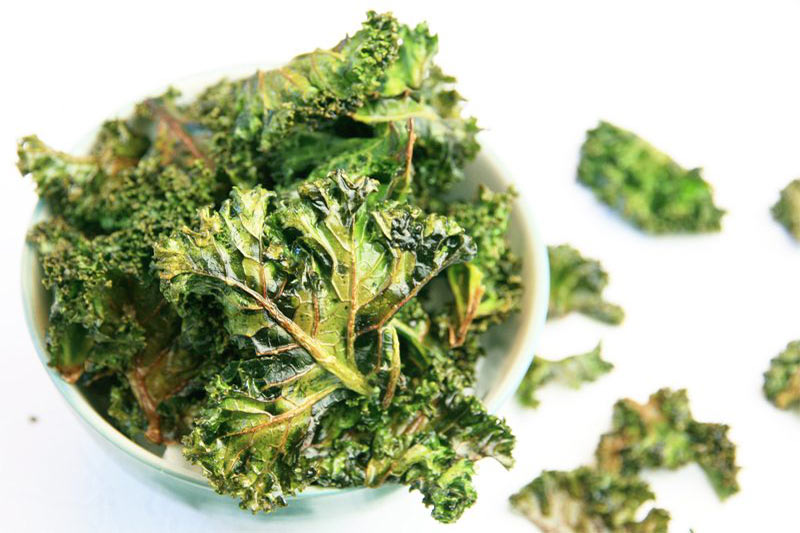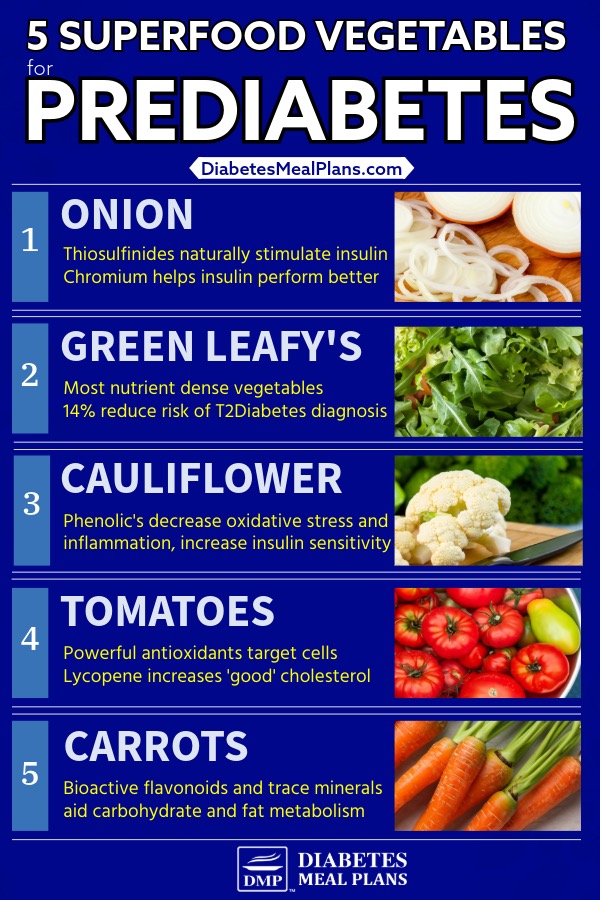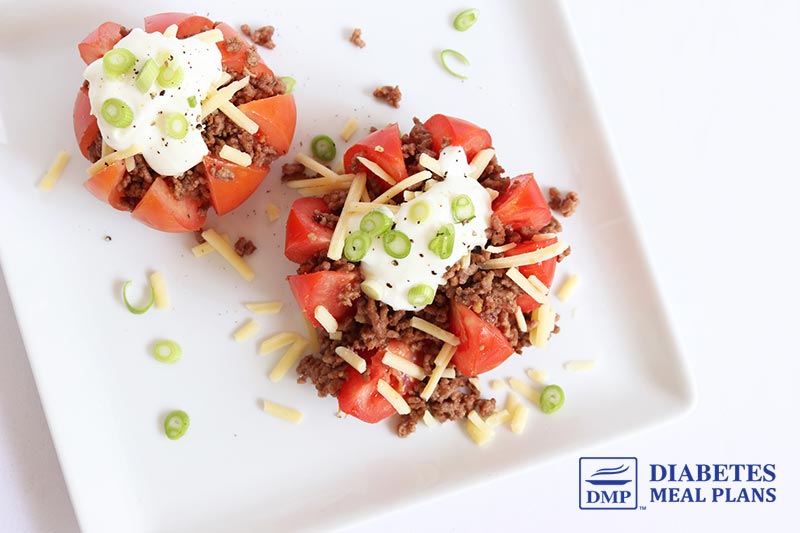Table of Contents[Hide][Show]
Research has shown that people with a higher daily vegetable intake have a lower risk of developing type 2 diabetes, which is of course important to you with prediabetes.
How many vegetables are we talking here: at least 4 servings a day, or ≥14oz (400g) day is the minimum aim.
Vegetables contain a wide array of bioactive compounds such as dietary fiber, polyphenols, minerals and vitamins that support optimal health.
Below we explore five science-backed superfood vegetables that can help boost your prediabetes health. For more foods, be sure to refer to our recommended food list below.

Prediabetes Food List: Grab Your Free Copy
Foods to eat and avoid, plus, 2 day sample menu
1. Onions
Onions come from the ‘allium’ family of vegetables, which include garlic, chives and leek as well.
The allium family of vegetables contain thiosulfinides, flavonoids, calcium, potassium, manganese, chromium; and onion is a good source of B vitamins and vitamin C.
Onions contain nearly 2g fiber per serve and we know dietary fiber is helpful to improve blood sugar levels.
According to research, allium vegetables are particularly beneficial for reducing risk of T2Diabetes, especially in women.
The thiosulfinides contained in onions and allium vegetables can help decrease blood sugar levels by stimulating insulin release from the pancreas, and the benefits of chromium can help insulin perform better.
TIP: Add sliced onions to a stir fry for dinner or finely diced red onion to a tuna salad for lunch.
2. Green Leafy Vegetables
Green leafy vegetables are super high in nutrient value. In fact, according to a CDC study, green leafy vegetables are the most nutrient dense veggies around – so that’s saying something!
Increasing your intake of green leafy vegetables by just one serving a day may reduce your risk of type 2 diabetes by 14%. What’s one serving? About a cup of leafy greens.
All leafy greens are highly nutritious, but the top ten standouts are spinach, kale, collard greens, Chinese cabbage, mustard greens, beet greens, chard, turnip greens, chicory and watercress.
You can eat as many green leafy’s as you like – eat them at every meal if you can. Or at the very least have one serve of them each day!
TIP: Add a bowl of greens at every meal, whether that be sauteed greens in olive oil, vinegar and garlic, or a bowl of fresh salad greens drizzled with lemon. Try these Spinach Stuffed Tomatoes for breakfast and for a snack, you can even make Kale Chips – might sound awful but it’s surprisingly delicious!

3. Cauliflower (or Broccoli)
Cauliflower and broccoli are cruciferous vegetables, part of the brassica family of vegetables, which includes Brussels sprouts, cabbage, kale and others.
Cruciferous vegetables contain fiber, antioxidant vitamins (vitamin C and β-carotene), antioxidant minerals (selenium), phenolic compounds, and sulfur compounds called GLS.
These powerful compounds can help decrease oxidative stress and inflammation associated with the development of prediabetes, and improving insulin resistance.
TIP: cauliflower makes a great lower carb alternative for potatoes, which are high in carbs. Try this tasty Cauliflower ‘Potato’ Salad.

4. Tomatoes
Tomato is a popular vegetable (although technically a fruit) that is eaten widely and can be used in meals cooked or raw.
Tomato contains lycopene, a carotenoid that gets stored primarily in the liver, fat tissue and endocrine glands in the body (adrenals, testes and prostate). Lycopene is a powerful free radical scavenger – a powerful antioxidant that can boost prediabetes health.
Something that often goes hand in hand with prediabetes is altered cholesterol. The good news is, increasing your lycopene intake can increase the good ‘HDL’ cholesterol to help reduce risk of cardiovascular disease.
TIP: We love making stuffed tomatoes! Like these Spinach Stuffed Tomatoes or Taco Tomatoes. Use any filler, stuff and bake for a deliciously satisfying meal.

5. Carrots
Carrots come from the Apiaceae family of vegetables. Carrots contain around 5.8g total carbs, 1.7g fiber and around 4.1g net carbs.
We do encourage a lower carb eating plan to reset your prediabetes health, and many people think that means excluding carrots, but that’s not the case at all.
Raw carrots have a particularly low glycemic index (GI) of only 16, while unpeeled boiled carrots are around 32 and peeled and boiled they are still low GI at 49.
While they do contain more carbohydrates than some other vegetables (green leafy vegetables, for example), they are still a lower carb vegetable. And the nutritional benefits derived from carrots are not worth their exclusion.
Carrots have a unique combination of three beneficial flavonoids: kaempferol, quercetin and luteolin, along with containing 42-61% bioactive phenols that exert health benefits. Carrots also contain a rare trace mineral – molybdenum, which aids in metabolism of fats and carbohydrates – two beneficial boosts for prediabetes metabolic health.
And, for men in particular, red and orange veggies are known to help reduce risk of type 2 diabetes.
Conclusion
All types of vegetables provide benefits for prediabetes health, as they contain bioactive compounds such as dietary fiber, polyphenols, minerals and vitamins that support optimal health.
In terms of vegetables, you want to aim for at least 4 servings a day, or ≥14oz (400g) day. But really, since we recommend cutting down on high carb foods like – rice, pasta and cereals – eating more than 4 serves a day should be easy; simply replace those high carb foods with more vegetables – your blood sugar and A1c will thank you for it!
In particular, you can include onions, green leafy vegetables, cauliflower, tomatoes and carrots, for their specific prediabetes health boosting properties.

Prediabetes Food List: Grab Your Free Copy
Foods to eat and avoid, plus, 2 day sample menu
References
- Kosti, R., Tsiampalis, T., Kouvari, M., Chrysohoou, C., Georgousopoulou, E., Pitsavos, C., & Panagiotakos, D. (2022). The association of specific types of vegetables consumption with 10-year type II diabetes risk: Findings from the ATTICA cohort study.. Journal of human nutrition and dietetics : the official journal of the British Dietetic Association. https://doi.org/10.1111/jhn.13056.
- Dias, J., & Imai, S. (2017). Vegetables Consumption and its Benefits on Diabetes. Journal of Nutritional Therapeutics, 6, 1-10. https://doi.org/10.6000/1929-5634.2017.06.01.1.
- Safabakhsh M, Koohdani F, Bagheri F, Siassi F, Khajehnasiri F, Sotoudeh G. Fruit and vegetable intake and pre-diabetes: a case-control study. Eur J Nutr. 2018 Dec;57(8):2953-2962. doi: 10.1007/s00394-017-1569-x. Epub 2017 Dec 4. PMID: 29204690.
- Carter P, Gray LJ, Troughton J, Khunti K, Davies MJ. Fruit and vegetable intake and incidence of type 2 diabetes mellitus: systematic review and meta-analysis. BMJ. 2010 Aug 18;341:c4229. doi: 10.1136/bmj.c4229. PMID: 20724400; PMCID: PMC2924474.
- Glycemic Index. The University of Sydney. https://glycemicindex.com
- Di Noia J. Defining Powerhouse Fruits and Vegetables: A Nutrient Density Approach. Prev Chronic Dis 2014;11:130390. DOI: http://dx.doi.org/10.5888/pcd11.130390
- Esteve M. Mechanisms Underlying Biological Effects of Cruciferous Glucosinolate-Derived Isothiocyanates/Indoles: A Focus on Metabolic Syndrome. Front Nutr. 2020 Sep 2;7:111. doi: 10.3389/fnut.2020.00111. PMID: 32984393; PMCID: PMC7492599.
- Xiaoting Wu et al. Tomato and lycopene and multiple health outcomes: Umbrella review, Food Chemistry, Volume 343, 2021, 128396, ISSN 0308-8146,https://doi.org/10.1016/j.foodchem.2020.128396.
- Inoue T, Yoshida K, Sasaki E, Aizawa K, Kamioka H. Effects of lycopene intake on HDL-cholesterol and triglyceride levels: A systematic review with meta-analysis. J Food Sci. 2021 Aug;86(8):3285-3302. doi: 10.1111/1750-3841.15833. Epub 2021 Jul 15. PMID: 34268742.
- da Silva Dias, J. (2014) Nutritional and Health Benefits of Carrots and Their Seed Extracts. Food and Nutrition Sciences, 5, 2147-2156. doi: 10.4236/fns.2014.522227.

Leave a Reply